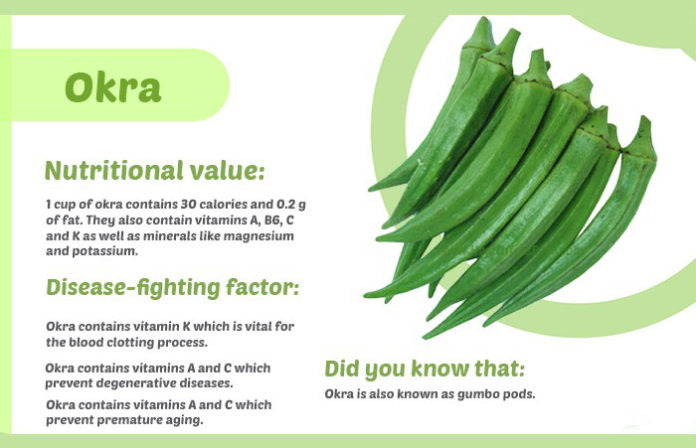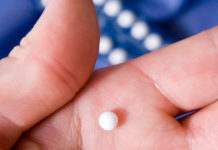Many people fail to appreciate okra (bhindi) because of its slimy texture. However, okras are popular for their nutritionally dense structure, particularly for their soluble and insoluble fiber content. This vegetable comes from the Malvaceae or mallows family and is related to cotton, hibiscus, and hollyhock.
This pod vegetable is available all year round, especially during summer, and thrives well in warm climates. It is naturally green but some varieties show a red color. Some types have a smooth surface, while others have a rough texture. Because okra is tough to chew, it is usually steamed or boiled before eating.
Okra is widely used all over the world and is known by several names. In some parts of the world, it is called “lady’s fingers” because of its long shape. In other areas, it is known as “gumbo,” which is believed to have come from “quingombo,” a Portuguese corruption of the word “quillobo.” The latter is the native name of okra in African countries, such as Congo and Angola. In France, it is known as “gombo,” while in Spain, it is named “quibombo.” It is called “Bhindi” in India and “bamies” in eastern Mediterranean and Arab countries.
Health Benefits of Okra
Okra is low-calorie. A 100-gram serving of okra contains only 30 calories and zero saturated fats and cholesterol. It is, however, high in soluble and insoluble fiber. The fiber in okra has been linked to several benefits, such as optimal digestive function, low cholesterol levels, reduced heart disease risk, and weight management. Because fibrous foods are more challenging to digest, you’ll feel more satiated when you eat them.
At the same time, okra is actually packed with nutrients. One of the key nutrients of this green crop is vitamin C – about 36 percent of the daily recommended amount. Increasing your intake of vitamin C-rich foods can help support your immune function, prevent free radical damage, and may help regulate blood pressure.
Okras are also a good source of B vitamins, such as vitamin B6 (pyridoxine). This nutrient aids in the metabolism of fat, carbohydrates, and amino acids, promotes the health of your lymph nodes, and can contribute to the regulation of blood sugar levels. Okras are also a good source of other B vitamins, such as niacin, thiamine, and pantothenic acid.
High levels of vitamin A and flavonoids such as beta-carotene, xanthin, and lutein can also be found in okras. These nutrients are associated with good vision, healthy skin and mucous membranes, and even increased protection from cancer.
Okras also provide vitamin K and folate. Vitamin K assists in your body’s blood clotting function and, together with vitamin D and calcium, supports your bone health. Folate is beneficial for pregnant women as it assists in child development.
Minerals that can also be found in this vegetable include iron, calcium, manganese, and magnesium.
why you should add Okra to your weight loss diet
Here is the reason why you should add Okra in your weight loss diet:
- High Fibre Content
Okra (bhindi) is packed with dietary fibre, which keeps you satiated and makes you feel full for a longer time. The fibre content in bhindi is not easily digested by the body, so it passes quickly through your system without causing the blood sugar levels to spike. The fibre aids the process of digestion in the body by facilitating proper bowel movement. This is mostly why all the nutritionists advise eating more fibre-rich foods for weight loss. According to Dr. Ritika Samaddar, who is a Delhi-based nutritionist, “Fibre is a very important part of our daily diet and we should include both types as it is very important to maintain a healthy balance. Soluble fibres are generally recommended to people suffering from diabetes or high sugar as they dissolve and keep the sugar level under control. Insoluble fibres help in losing weight and also maintain the smooth functioning of the gastric system. An average adult should take about 15 grams of fibre every day.”
Okra (bhindi) falls in the category of low-calorie veggies and contains no saturated fats. This makes bhindi a perfect addition to the diet of a weight watcher. Include okra in your diet and add flavours to your meal while maintaining a low-calorie count, which helps manage weight.
- Low Fat Veggie
The fat content in bhindi is 0.3 g or less than 1 per cent of the 65-gram serving of okra as per the USDA. Fat is a nutrient that provides a high number of calories in the diet – one gram of fat has nine calories.
- Low Glycaemic Index (GI)
The glycaemic index of bhindi is in the low range, which has minimal effects on our blood glucose. According to the American Diabetes Association, non-starchy vegetables, such as bhindi, are low glycaemic index foods and can be freely enjoyed by diabetics and the ones who are watching their weight.
Benefit of Okra Juice

10 Amazing Health Benefits Of Drinking Okra Juice
Okra is a well known vegetable, which is grown and consumed in almost every part of the world. Commonly known as “Lady Finger”, okra is a nutritious and healthy vegetable. The taste of okra depends upon its preparation. Most people share a love hate relation with okra—you can love it or hate it, but cannot ignore it!
The okra belongs to the mallow family and is cultivated in warm and temperate climates. As a vegetable, it contains many vitamins and minerals, which are essential for the body. Not just as a vegetable, but you can get all its goodness from its juice too.
Top 10 Benefits Of Drinking Okra Juice:
Some of the benefits of drinking okra juice are given below. Read on to know more:
1. Anemia:
A person suffering from anemia can derive the benefits of this vegetable from its juice. Okra juice helps the body produce more red blood cells, which helps to treat anemia. The juice of okra contains many vitamins and minerals. Some of them are Vitamin-A, Vitamin-C, magnesium, etc., which help in producing more red blood cells in the body.
Sore Throat And Cough:
Okra juice is also used to treat sore throat and severe cough. A person suffering from sore throat and cough can consume okra juice. Its antibacterial and antiseptic properties will do their magic!
3. Diabetes:
Lady Finger contains insulin like properties, which are beneficial for the treatment of diabetes. Okra juice helps to reduce sugar levels in the blood. So, consume okra juice regularly to control diabetes.
4. Helps To Treat Diarrhea:
Diarrhea is one of the most irritating health conditions one can suffer from. It causes huge amount water and essential minerals loss from the body. The juice of okra is used in the treatment of diarrhea and it also helps to replenish the body.
5. Lowers Cholesterol Level:
The plant contains a lot of soluble fibers, which can help the body to lower the cholesterol level. The regular consumption of this juice can decrease the cholesterol level in the blood and protect your heart.
6. Provides Relief From Constipation:
The same soluble fiber, which can help to control the cholesterol levels in the blood, also helps to provide relief from constipation. Acting as a natural laxative, the fiber content in okra binds with the toxins and eases the bowel movements.
7. Helps In Improving Immune System:
The immune system helps the body fight against various diseases, such as cold and flu. Okra juice contains high amounts of Vitamin-C and antioxidants, which help to improve the immunity power of a person.
8. Improves Skin Health:
Regular consumption of okra juice helps to improve the skin health. The antioxidants help to purify the blood and reduce acne and other skin diseases, which are caused by the impurities in the blood. A clearer skin equals a beautiful skin!
9. Reduces Asthma Attacks:
The juice of okra also reduces the chances of asthmatic attacks and is of great benefit for a person suffering from asthma.
10. Strengthens Bones:
This health benefit of okra juice helps to strengthen the bones. The folate offers great benefits during the pregnancy for both the mother and the child. It increases the density of the bones resulting in stronger and healthier bones, preventing osteoporosis.
As a vegetable, okra contains many essential vitamins, minerals and antioxidants, which help the body, fight various diseases and improve its immunity. Due to its many characteristic features, it is one of the top vegetables that must be consumed on a regular basis. So start juicing those okras and enjoy a life of good health!
| Amt. Per Serving |
% Daily Value* |
|
|---|---|---|
| Calories | 31 | |
| Calories from Fat | 1 | |
| Total Fat | 0 g | 1% |
| Saturated Fat | 0 g | 0% |
| Trans Fat | ||
| Cholesterol | 0 mg | 0% |
| Sodium | 8 mg | 0% |
| Total Carbohydrates | 7 g | 2% |
| Dietary Fiber | 3 g | 13% |
| Sugar | 1 g | |
| Protein | 2 g | |
| Vitamin A7% | Vitamin C | 35% |
| Calcium8% | Iron | 4% |
*Percent Daily Values are based on a 2,000 calorie diet. Your daily values may be higher or lower depending on your calorie needs.
Okra Fun Facts
Okra originated in Egypt and has been grown there since the 12th century. Its use spread throughout the North Africa, the Middle East, and Europe. Later on, it was cultivated in North America and today is frequently added to southern cooking. When cut, okras produce a liquid that is used to thicken stews or “gumbos.”
Okra can be enjoyed in a number of ways. In tropical countries, the okra pods are chopped or sliced, then used in stews or fried under low heat to soften their mucilaginous liquid. They are often served with other vegetables, rice, or meat. In the Caribbean, okra is added in soups and served with fish. It can also be fermented like other vegetables, and its leaves can be used in salads.
Did you know that okra can be used on your hair? Boil okra and apply the transparent mucilage – the slimy juice derived from the vegetable – on your hair as a hair conditioner. Doing so can help moisturize your hair, fight dandruff, and even give added shine.




















































